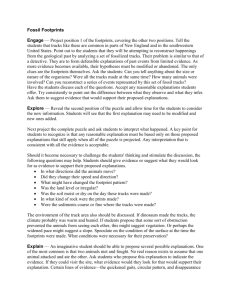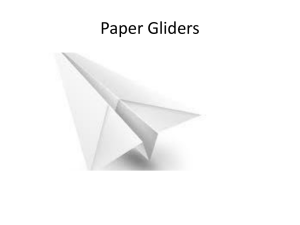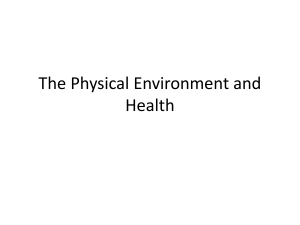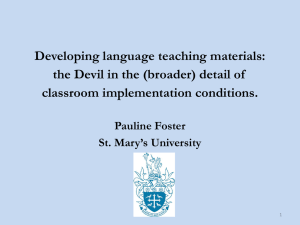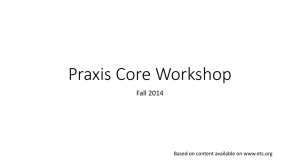ACTIVITY: Proposing Explanations for Fossil Footprints
advertisement
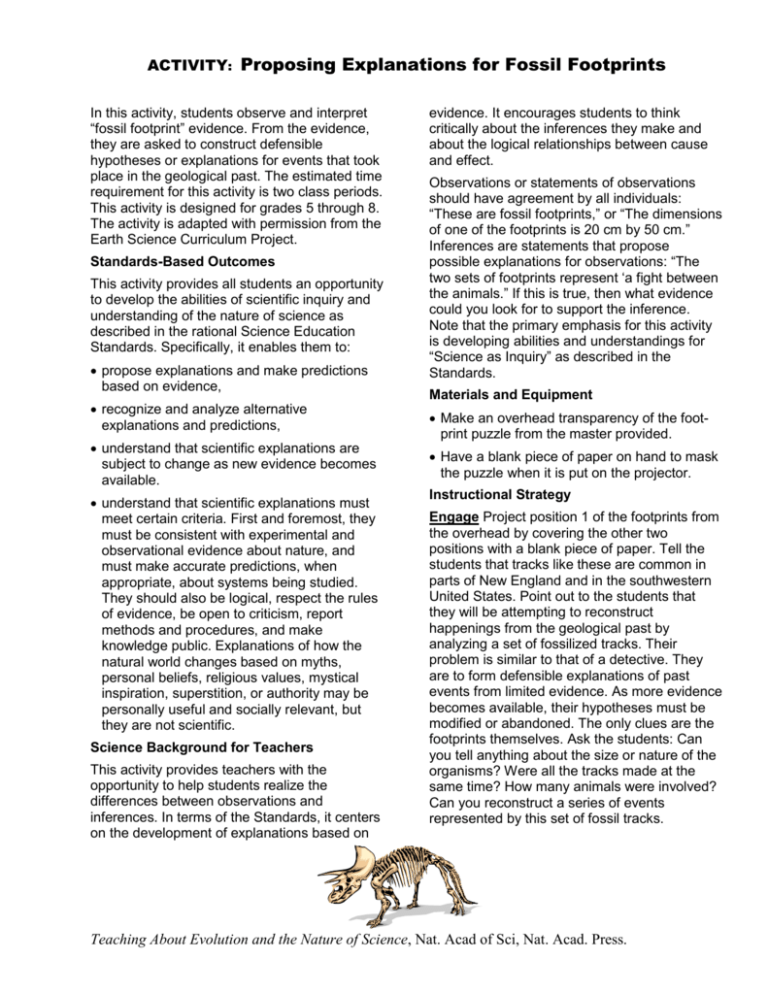
ACTIVITY: Proposing Explanations for Fossil Footprints In this activity, students observe and interpret “fossil footprint” evidence. From the evidence, they are asked to construct defensible hypotheses or explanations for events that took place in the geological past. The estimated time requirement for this activity is two class periods. This activity is designed for grades 5 through 8. The activity is adapted with permission from the Earth Science Curriculum Project. Standards-Based Outcomes This activity provides all students an opportunity to develop the abilities of scientific inquiry and understanding of the nature of science as described in the rational Science Education Standards. Specifically, it enables them to: propose explanations and make predictions based on evidence, recognize and analyze alternative explanations and predictions, understand that scientific explanations are subject to change as new evidence becomes available. understand that scientific explanations must meet certain criteria. First and foremost, they must be consistent with experimental and observational evidence about nature, and must make accurate predictions, when appropriate, about systems being studied. They should also be logical, respect the rules of evidence, be open to criticism, report methods and procedures, and make knowledge public. Explanations of how the natural world changes based on myths, personal beliefs, religious values, mystical inspiration, superstition, or authority may be personally useful and socially relevant, but they are not scientific. Science Background for Teachers This activity provides teachers with the opportunity to help students realize the differences between observations and inferences. In terms of the Standards, it centers on the development of explanations based on evidence. It encourages students to think critically about the inferences they make and about the logical relationships between cause and effect. Observations or statements of observations should have agreement by all individuals: “These are fossil footprints,” or “The dimensions of one of the footprints is 20 cm by 50 cm.” Inferences are statements that propose possible explanations for observations: “The two sets of footprints represent ‘a fight between the animals.” If this is true, then what evidence could you look for to support the inference. Note that the primary emphasis for this activity is developing abilities and understandings for “Science as Inquiry” as described in the Standards. Materials and Equipment Make an overhead transparency of the footprint puzzle from the master provided. Have a blank piece of paper on hand to mask the puzzle when it is put on the projector. Instructional Strategy Engage Project position 1 of the footprints from the overhead by covering the other two positions with a blank piece of paper. Tell the students that tracks like these are common in parts of New England and in the southwestern United States. Point out to the students that they will be attempting to reconstruct happenings from the geological past by analyzing a set of fossilized tracks. Their problem is similar to that of a detective. They are to form defensible explanations of past events from limited evidence. As more evidence becomes available, their hypotheses must be modified or abandoned. The only clues are the footprints themselves. Ask the students: Can you tell anything about the size or nature of the organisms? Were all the tracks made at the same time? How many animals were involved? Can you reconstruct a series of events represented by this set of fossil tracks. Teaching About Evolution and the Nature of Science, Nat. Acad of Sci, Nat. Acad. Press. Have the students discuss each of the questions. Accept any reasonable explanations students offer. Try consistently to point out the difference between what they observe and what they infer. Ask them to suggest evidence that would support their proposed explanations. Explore Reveal the second position of the puzzle and allow time for the students to consider the new information. Students will see that the first explanation may need to be modified and new ones added. Next project the complete puzzle and ask students to interpret what happened. A key point for students to recognize is that any reasonable explanation must be based only on those proposed explanations that still apply when all of the puzzle is projected. Any interpretation that is consistent with all the evidence is acceptable. Should it become necessary to challenge the students’ thinking and stimulate the discussion, the following questions may help. Students should give evidence or suggest what they would look for as evidence to support their proposed explanations. In what directions did the animals move? Did they change their speed and direction? What might have changed the footprint pattern? Was the land level or irregular? Was the soil moist or dry on the day these tracks were made? In what land of rock were the prints made? Were the sediments coarse or fine where the tracks were made? The environment of the track area also should be discussed. If dinosaurs made the tracks, the climate probably was warm and humid. If students propose that some sort of obstruction prevented the animals from seeing each other, this might suggest vegetation. Or perhaps the widened pace might suggest a slope. Speculate on the condition of the surface at the time the footprints were made. What conditions were necessary for their preservation? Explain An imaginative student should be able to propose several possible explanations. One of the most common is that two animals met and fought. No real reason exists to assume that one animal ate the other. Ask students who propose this explanation to indicate the evidence. If they could visit the site, what evidence would they look for that would support their explanation? Certain lines of evidence — the quickened gaits, circular pattern, and disappearance of one set of tracks — could support the fight explanation. They might, however, support an explanation of a mother picking up her baby. The description and temperament of the animals involved are open to question. Indeed, we lack the evidence to say that the tracks were made at the same time. The intermingling shown in the middle section of the puzzle may be evidence that both tracks were made at one time but it could be only a coincidence. Perhaps one animal passed by and left and then the other arrived. Discuss the expected learning outcomes related to scientific inquiry and the nature of science. To answer the questions posed by the set of fossil footprints, the students, like scientists, constructed reasonable explanations based solely on their logical interpretation of the available evidence. They recognized and analyzed alternative explanations by weighing the evidence and examining the logic to decide which explanations seemed most reasonable. Although there may have been several plausible explanations, they did not all have equal weight. In a manner similar to the way scientists work. students should be able to use scientific criteria to find, communicate, and defend the preferred explanation. Elaborate You can have more discussions on interpreting series of events using animal prints students find outdoors and reproduce for the class. Do not forget to look for human footprints. Have students design a different fossil footprint puzzle. Choose several different ones and have student teams repeat the activity using the same learning goals. Evaluate Describe a specific event involving two or more people or animals where footprint evidence remains. Ask the students, either in teams or individually, to diagram footprint evidence that could lead to several different, yet defensible, explanations regarding what took place. They should be able to explain the strengths and weaknesses of each explanation using their footprint puzzle. Teaching About Evolution and the Nature of Science, Nat. Acad of Sci, Nat. Acad. Press. MISSION 1. Reconstruct happenings from the geological past by analyzing a set of fossilized tracks. 2. Form defensible explanations of past events from limited evidence. 3. As more evidence becomes available, modify or abandon your hypotheses. I. Questions to Address After Viewing Position #1: A. Can you tell anything about the size or nature of the organisms? B. Were all the tracks made at the same time? C. How many animals were involved? D. Can you reconstruct a series of events represented by this set of fossil tracks? Suggest evidence that would support your proposed explanations. II. After viewing Position #2: A. After considering the new information, revisit your first explanation. B. Modify your explanation and/or add new ones. Teaching About Evolution and the Nature of Science, Nat. Acad of Sci, Nat. Acad. Press. III. After viewing Position #3: A. Interpret what happened. Remember...Any reasonable explanation must be based only on those proposed explanations that still apply when all of the puzzle is projected. B. Some questions to consider: 1. In what direction did the animals move? 2. Did they change their speed and direction? 3. What might have changed the footprint pattern? 4. Was the land level or irregular? 5. Was the soil moist or dry on the day these tracks were made? 6. In what kind of rock were the prints made? 7. Were the sediments coarse or fine where the tracks were made? 8. What was the environment of the track area like? For each possible explanation proposed, be sure to indicate the evidence. If you could visit the site, what evidence would you look for that would support your explanation? Teaching About Evolution and the Nature of Science, Nat. Acad of Sci, Nat. Acad. Press. Teaching About Evolution and the Nature of Science, Nat. Acad of Sci, Nat. Acad. Press.
